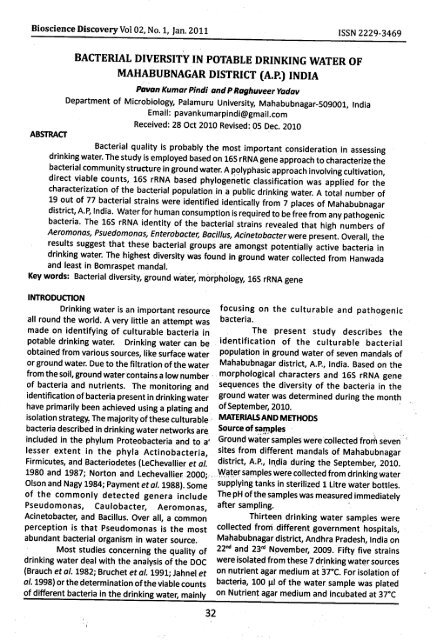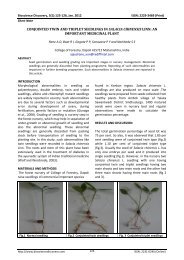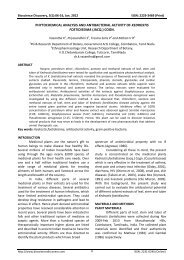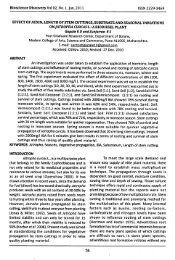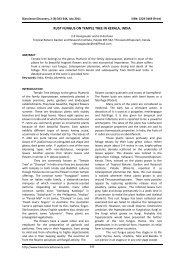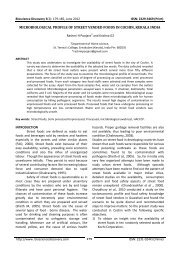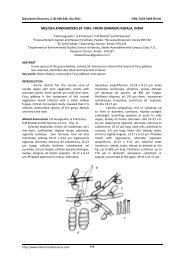bacterial diversity in potable drinking water of mahabubnagar district
bacterial diversity in potable drinking water of mahabubnagar district
bacterial diversity in potable drinking water of mahabubnagar district
You also want an ePaper? Increase the reach of your titles
YUMPU automatically turns print PDFs into web optimized ePapers that Google loves.
Bioscience Discovery Vol 02, No. t, lan.Z}tL ISSN 2229-3469<br />
ABSTRACT<br />
BACTERIAT DIVERSITY IN POTABTE DRINKING WATER OF<br />
MAHABUBNAGAR DISTRICT (A.P.) INDIA<br />
Paian Kumar p<strong>in</strong>di and p Raghuveeryadav<br />
Department <strong>of</strong> Microbiology, Palamuru university, Mahabubnagar-50g001, lndia<br />
Email: pavankumarp<strong>in</strong>di@gmail.com<br />
Received:28 Oct 2010 Revised:05 Dec. 2010<br />
Bacterial quality is probably the most important consideration <strong>in</strong> assess<strong>in</strong>g<br />
dr<strong>in</strong>k<strong>in</strong>g <strong>water</strong>. The study is employed based on 16s rRNA gene approach to characterize the<br />
<strong>bacterial</strong> community structure <strong>in</strong> ground <strong>water</strong>. A polyphasic approach <strong>in</strong>volv<strong>in</strong>g cultivation,<br />
direct viable counts, 16s rRNA based phylogenetic classification was applied for the<br />
characterization <strong>of</strong> the <strong>bacterial</strong> population <strong>in</strong> a public dr<strong>in</strong>k<strong>in</strong>g <strong>water</strong>. A total number <strong>of</strong><br />
19 out <strong>of</strong> 77 <strong>bacterial</strong> stra<strong>in</strong>s were identified identically from i places <strong>of</strong> Mahabubnagar<br />
<strong>district</strong>, A.B lndia. Water for human consumption is required to be free from any pathoge-nic<br />
bacteria. The 165 rRNA identity <strong>of</strong> the <strong>bacterial</strong> stra<strong>in</strong>s revealed that high numbeis <strong>of</strong><br />
Aeromonos, Psuedomonas, Enterobacter, Bacillus, Ac<strong>in</strong>etobocterwere present. overall, the<br />
results suggest that these <strong>bacterial</strong> groups are amongst potentially active bacteria <strong>in</strong><br />
dr<strong>in</strong>k<strong>in</strong>g <strong>water</strong>. The highest <strong>diversity</strong> was found <strong>in</strong> ground <strong>water</strong> collected from Hanwada<br />
and least <strong>in</strong> Bomraspet mandal.<br />
Key words: Bacterial <strong>diversity</strong>, ground <strong>water</strong>, morphology, 165 rRNA gene<br />
INTRODUCTION<br />
Dr<strong>in</strong>k<strong>in</strong>g <strong>water</strong> is an important resource<br />
all round the world. A very little an attempt was<br />
made on identify<strong>in</strong>g <strong>of</strong> culturable bacteria <strong>in</strong><br />
<strong>potable</strong> dr<strong>in</strong>k<strong>in</strong>g <strong>water</strong>. Dr<strong>in</strong>k<strong>in</strong>g <strong>water</strong> can be<br />
obta<strong>in</strong>ed from various sources, like surface <strong>water</strong><br />
or ground <strong>water</strong>. Due to the filtration <strong>of</strong> the <strong>water</strong><br />
from the soil, ground <strong>water</strong> conta<strong>in</strong>s a low number<br />
<strong>of</strong> bacteria and nutrients. The monitor<strong>in</strong>g and<br />
identification <strong>of</strong> bacteria present <strong>in</strong> dr<strong>in</strong>k<strong>in</strong>g <strong>water</strong><br />
have primarily been achieved us<strong>in</strong>g a plat<strong>in</strong>g and<br />
isolation strategy. The majority <strong>of</strong> these culturable ,<br />
bacteria described <strong>in</strong> dr<strong>in</strong>k<strong>in</strong>g <strong>water</strong> networks are<br />
<strong>in</strong>cluded <strong>in</strong> the phylum proteobacteria and to a,<br />
lesser extent <strong>in</strong> the phyla Act<strong>in</strong>obacteria,<br />
Firmicutes, and Bacteriodetes (LeChevallier et a/.<br />
1980 and 1987; Norton and Lechevallier 2000;<br />
Olson and Nagy 1984; payment ef a/. 19g8). Some<br />
<strong>of</strong> the commonly detected genera <strong>in</strong>clude<br />
Pseudomonas, Caulobacter, Aeromonas,<br />
Ac<strong>in</strong>etobacter, and Bacillus. Over all, a common<br />
perception is that pseudomonas is the most<br />
abundant <strong>bacterial</strong> organism <strong>in</strong> <strong>water</strong> source.<br />
Most studies concern<strong>in</strong>g the quality <strong>of</strong><br />
dr<strong>in</strong>k<strong>in</strong>g <strong>water</strong> deal with the analysis <strong>of</strong> the DOC<br />
(Brauch et a l. t982; Bru chet et a l. L99t;Jah nel et<br />
o/. 1998) or the determ<strong>in</strong>ation <strong>of</strong> the viable counts<br />
<strong>of</strong> different bacteria <strong>in</strong> the dr<strong>in</strong>k<strong>in</strong>g <strong>water</strong>,<br />
focus<strong>in</strong>g on the culturable and pathogenic<br />
bacteria.<br />
The present study describes the<br />
identification <strong>of</strong> the culturable <strong>bacterial</strong><br />
population <strong>in</strong> ground <strong>water</strong> <strong>of</strong> seven mandals <strong>of</strong><br />
Mahabubnagar <strong>district</strong>, A.p., lndia. Based on the<br />
morphological characters and 165 rRNA gene<br />
sequences the <strong>diversity</strong> <strong>of</strong> the bacteria <strong>in</strong> the<br />
ground <strong>water</strong> was determ<strong>in</strong>ed dur<strong>in</strong>g the month<br />
<strong>of</strong> September,2010.<br />
MATERIAISANDMETHODS<br />
Source <strong>of</strong> samples<br />
Ground <strong>water</strong> samples were collected from seven<br />
sites from different mandals <strong>of</strong> Mahabubnagar<br />
<strong>district</strong>, A.P., lndia dur:<strong>in</strong>g the September, 2010.<br />
[g!.er samples were collected from dr<strong>in</strong>k<strong>in</strong>g <strong>water</strong><br />
supply<strong>in</strong>g tanks <strong>in</strong> sterilized 1 Litre <strong>water</strong> bottles.<br />
The pH <strong>of</strong> the samples was measured immediately<br />
after sampl<strong>in</strong>g.<br />
Thirteen dr<strong>in</strong>k<strong>in</strong>g <strong>water</strong> samples were<br />
collected froni different government hospitals,<br />
Mahabubnagar <strong>district</strong>, Andhra pradesh, lndia on<br />
22d and 23d November, 2009. Fifty five stra<strong>in</strong>s<br />
were isolated from these 7 dr<strong>in</strong>k<strong>in</strong>g <strong>water</strong> sources<br />
on nutrient agar medium at 37"C. For isolation <strong>of</strong><br />
bacteria, 100 pl <strong>of</strong> the <strong>water</strong> sample was plated<br />
on Nutrient agar medium and <strong>in</strong>cubated at 37'C
Pavon Kumar Plndi and P Raghuveer yodav<br />
for 2-days. Based on the different colony<br />
morphology from each sample, a total <strong>of</strong> 77 stra<strong>in</strong>s<br />
were selected and characterized <strong>in</strong> the present<br />
study.<br />
Genomic DNA isolation<br />
The genomic DNA from the <strong>bacterial</strong>cells<br />
was obta<strong>in</strong>ed us<strong>in</strong>g a modification <strong>of</strong> the method<br />
described by Sambrock et o/. (1989). The <strong>bacterial</strong><br />
cells from pure cultures were harvested by<br />
centrifugation (12,000 rpm)for 2 m<strong>in</strong>, and the cell<br />
pellets mixed with 600 il <strong>of</strong> lysis buffer (L0 mM<br />
Tris-HCl, 1 mM EDTA [pH 7.5],0.S% SDS, and 100<br />
ig/ml prote<strong>in</strong>ase K) and <strong>in</strong>cubated at 37" C for t h.<br />
After the addition <strong>of</strong> 100 it 5 M NaCt, and 80 il<br />
CTAB/NaCI, the samples were <strong>in</strong>cubated at 65" C<br />
for 10 m<strong>in</strong>. The samples were cooled to room<br />
temperature, followed by extraction <strong>of</strong> the aqueous<br />
phase with an equal volume <strong>of</strong> chlor<strong>of</strong>orm:<br />
isoamyl alcohol (24l. l, v/v), and then with an<br />
equal volume <strong>of</strong> phenol: chlor<strong>of</strong>orm: isoamyl<br />
alcohol (25: 24:- L, vfvl, which was centrifuged at<br />
12,000 rpm and 4oC for 10 m<strong>in</strong>. lsopropanol (0.6<br />
x) was mixed with the aqueous phase, and<br />
centrifuged at 12,000 rpm and 4 C for 10 m<strong>in</strong>.<br />
After removal <strong>of</strong> the aqueous phase, the DNA<br />
pellets were washed with 70% ethanol, and<br />
centrifuged at 12,000 rpm and 4 C for 10 m<strong>in</strong>, The<br />
DNA pellets were dried under vacuum, and then<br />
dissolved <strong>in</strong> TE buffer (10 mM Tris-HCl, and L<br />
mMEDTA [pH z.s] ).<br />
2.2. 165 rRNA gene sequenc<strong>in</strong>g and phylogenetic<br />
anatysis<br />
For 165 rRNA gene sequenc<strong>in</strong>g, DNA was prepared<br />
us<strong>in</strong>g the Mo Bio microbial DNA isolation kit (Mo<br />
Bio Laboratories lnc., Solano Beach, CA, USA) and<br />
sequenced as described previously (Lane 1991).<br />
The resultant almost complete sequence <strong>of</strong> the<br />
165 rRNA gene conta<strong>in</strong>ed 1502 nucleotides. The<br />
165 rRNA gene sequence <strong>of</strong> the isolate was<br />
subjected to BLAST sequence similarity search<br />
(Altschul et a/. 1990) and EzTaxon (Chun ef o/.<br />
2007) to identify the nearest taxa. The entire<br />
related 165 rRNA gene sequences were<br />
downloaded from the database (http://<br />
www.ncbi.nlm.nih..sov) aligned us<strong>in</strong>g the<br />
CLUSTAL_X program (Thompson et at. L9971.<br />
Table 1. Bacterial abundanoe <strong>in</strong> <strong>potable</strong> dr<strong>in</strong>k<strong>in</strong>g <strong>water</strong> samples collected from Mahabubnagar.<br />
Place <strong>of</strong>the Number <strong>of</strong><br />
collection lsolates<br />
Name<strong>of</strong> the lsdate<br />
Vapur<br />
05 Ac<strong>in</strong>etobader junii, Aeromonos hydrophilo, psuedomianas<br />
otitidis, Bacillus cereus, E,coli<br />
Koilkonda<br />
o4<br />
Methylobocteri um calcooceticus, Aeronmonos p unctato, Bo ci ll us<br />
<strong>in</strong>fontis. E.coli<br />
Kodangal<br />
03<br />
Hanwada<br />
07<br />
Bomraspet<br />
Maddur<br />
Kosgi<br />
01<br />
02<br />
06<br />
RESUTTSAND DISCUSSION<br />
Overall, the results suggest that these<br />
<strong>bacterial</strong> groups are mesophilic and could grow<br />
<strong>in</strong> the temperature range <strong>of</strong> 20 to 40.C with<br />
optimum growth temperature is 37.C. All the<br />
stra<strong>in</strong>s could grow without NaCl <strong>in</strong> the medium<br />
and the tolerance to NaCl varied from tto 2%,. All<br />
stra<strong>in</strong>s could grow either <strong>in</strong> the pH range <strong>of</strong> 6-g,<br />
A total <strong>of</strong> 77 <strong>bacterial</strong> stra<strong>in</strong>s werb recovered<br />
from the 7 dr<strong>in</strong>k<strong>in</strong>g <strong>water</strong> sources (Table 1).<br />
C it robact er Freu nd i i, Ba ci ll us c e re us, Boc i lt us ni o be nsis,<br />
Ac<strong>in</strong>etobacter urs<strong>in</strong>gii, Ac<strong>in</strong>etobacter junii, Aeromonos<br />
hydrophila, Psuedomonos olcaligenes, pseudomonas otitidis,<br />
' Lysi n! bacil t us fu sifor mi s, E. m li,<br />
Citrobacter sp<br />
De lfti a I ocu stri s, B rev ibo cter iu m sp.<br />
Bocillus sp, Pseudomonos aerugirtosa, Citrobocter Freundii ,<br />
A fth robocte r sp. Ac<strong>in</strong> etobocte r E.coli<br />
33<br />
Morphological and taxonomic analysis <strong>of</strong> all the<br />
77 stra<strong>in</strong>s isolated from <strong>water</strong> samples <strong>in</strong>dicated<br />
that 19 stra<strong>in</strong>s were identical. The nearest<br />
phylogenetic neighbor <strong>of</strong> all 77 isolated stra<strong>in</strong>s<br />
were identified follow<strong>in</strong>g BLAST analysis <strong>of</strong> the<br />
165 rRNA gene sequence. BLAST analysi; <strong>in</strong>dicated<br />
that four stra<strong>in</strong>s belonged to th€ genus Bacillus ,<br />
three stra<strong>in</strong>s belonged to the genus ps uedomonos,<br />
each two stra<strong>in</strong>s belonged to the genus
Bioscience DiscoveryVol02, No. 1, Ian.2011<br />
Ac<strong>in</strong>etobocter , Aeromonos , each one stra<strong>in</strong> to the<br />
Brevibacterium sp. Citrobacter Freundii, "Delftia<br />
locustris, Lys<strong>in</strong>ibocillus fusiformis, E.coli,<br />
M e thy I o b o cte ri u m co I co a ceficus. Tota I i.9 d ifferent<br />
taxa were identified based on the BTAST analysis<br />
oul <strong>of</strong> 77 stra<strong>in</strong>s.<br />
Coli form is the name <strong>of</strong> a test adopted <strong>in</strong><br />
1914 by the Public Health Service for the<br />
Enterobocterioceae family. lt is the commonly-used<br />
<strong>bacterial</strong> <strong>in</strong>dicator <strong>of</strong> sanitary quality <strong>of</strong> foods<br />
and <strong>water</strong>. Coli form bacteria live <strong>in</strong> soil or<br />
vegetation and <strong>in</strong> the gastro<strong>in</strong>test<strong>in</strong>al tract <strong>of</strong><br />
animals. Coli forms enter <strong>water</strong> supplies from the<br />
direct disposal <strong>of</strong> waste <strong>in</strong>to streams or lakes or<br />
from run<strong>of</strong>ffrom wooded areas, pastures, feedlots,<br />
septic tanks, and sewage plants <strong>in</strong>to streams or<br />
ground<strong>water</strong>. Coli forms are not a s<strong>in</strong>gle type <strong>of</strong><br />
bacteria, but a group<strong>in</strong>g <strong>of</strong> bacteria that <strong>in</strong>cludes<br />
many stra<strong>in</strong>s, such as E. coli. Water sample from<br />
Hamada shown more contam<strong>in</strong>ation and less<br />
found <strong>in</strong> Bomraspet mandal.<br />
ln the present study species belong to the<br />
genera Aero monos, M ethylobode ri u m, Bqcill us and<br />
Pseudomonas were isolated which is supported<br />
by the different studies where several novel species<br />
which belong to the genera Aeromonos,<br />
Methylobocterium (Lee et a/. 2009), Bocillus(Zhang<br />
et o1.20061 and Pseudomonos were reported from<br />
dr<strong>in</strong>k<strong>in</strong>g <strong>water</strong> systems. Aeromonas spp. and<br />
Aeromonos hydrophila found <strong>in</strong> diverse aquatic<br />
environments like well<strong>water</strong> and heavily polluted<br />
ISSN 2229-3469<br />
<strong>water</strong>s and survives easily <strong>in</strong> <strong>water</strong>s polluted by<br />
various dis<strong>in</strong>fectants and chemicals.<br />
ln the present study species belong to the genus<br />
Ac<strong>in</strong>etobacter from Vepur, Hanwada and Kosgi,<br />
Bocillus cereus from Vapur and Kodangal and<br />
Pseudomonos oerug<strong>in</strong>oso from Kosgi, Aeromonos<br />
hyd ro ph i I o |/'uys et o/. 2@21, B a c i t I us cereus (Suth a r<br />
et a1.2008b1, Cupriavidus pauculus (Vandamme et<br />
a/. 1999) and Pseudomonos aerug<strong>in</strong>oso (Suthar ef<br />
o/. 2008b). Bacillus <strong>in</strong>fantis which cause sepsis was<br />
isolated from cl<strong>in</strong>ical specimens (Ko et o/. 2006)<br />
which are opportunistic pathogens were isolated.<br />
coNcrustoN<br />
More <strong>in</strong>formation about the microorganisms and<br />
their metabolism is important to determ<strong>in</strong>e the<br />
techniques, which should be applied before<br />
ground <strong>water</strong> can be used as dr<strong>in</strong>k<strong>in</strong>g <strong>water</strong> <strong>in</strong><br />
order to take precautions to avoid health problems<br />
at problematic places. The results from this study<br />
further improve our understand<strong>in</strong>g <strong>of</strong> the<br />
molecular <strong>diversity</strong> and <strong>bacterial</strong> population<br />
dynamics <strong>of</strong> dr<strong>in</strong>k<strong>in</strong>g <strong>water</strong> microbial<br />
communities. Moreover, these results provide the<br />
sequence foundation for the development <strong>of</strong><br />
molecular assay that target active dr<strong>in</strong>k<strong>in</strong>g <strong>water</strong><br />
bacteria. The public must also recognize that<br />
public dr<strong>in</strong>k<strong>in</strong>g <strong>water</strong> is not frequently monitored<br />
by health laboratories for acceptable quality. The<br />
supplemental treatment measures will require<br />
careful <strong>in</strong>-plant monitor<strong>in</strong>g and ma<strong>in</strong>tenance to<br />
prevent <strong>in</strong> <strong>water</strong> quality enhancement.<br />
TMRATURECITED<br />
Altschul S F, Cish W, Mitler W Myers E W and Lipman D J. 1990. Basic local alignment search tool.<br />
Moleculor Biolog'y 215: 403-410.1<br />
Brauch H J, Volker E and Frick B R . 1982. Uberlegungen zur charakterisierung irga4ischer<br />
Wasser<strong>in</strong>haltst<strong>of</strong>fe uber ihre adsorbierbarkeit an Aktivkohle. Ver<strong>of</strong>fentlichungen des Bereichsund der<br />
Lehrstuhle fur Wasserchemie und der DVGW Forschungasstelle am Engler-Bunte-lnstitut der Universitat<br />
Karlsruhe, Heft 20, 43-62.<br />
Bruchet A, Legrand M F, Arp<strong>in</strong>o P and Dilettato D.1991. Recent methods for the determ<strong>in</strong>ation <strong>of</strong><br />
volatile and non-volatile organic compounds <strong>in</strong> natural and purifiled dr<strong>in</strong>k<strong>in</strong>g <strong>water</strong>. Fournol'<strong>of</strong><br />
ch ro motog ra phy 562: 469-480.<br />
Chun J, Lee J H, Jung Y, Kim M, Kim $ Kim B K and Um Y W. 2007. EzTaxon: a web-based tool for the<br />
identification <strong>of</strong> prokaryotes based on 165 ribosomal RNAgene sequences. tntJ Syst EvotMicrobiotsT:<br />
2259-226L.<br />
FelfiildiT, Hedger Z, Vargha M and Mdrialigeti K. 2010. Detection <strong>of</strong> potentially pathogenic bacteria <strong>in</strong><br />
the dr<strong>in</strong>k<strong>in</strong>g <strong>water</strong> distribution system <strong>of</strong> a hospital <strong>in</strong> Hungary. Cl<strong>in</strong>ical Microbiot lnfections. 16: 89-92.<br />
34
Pavan Kumor P<strong>in</strong>di and P Raghuveer Yadqv<br />
Huys G, Kdmpfer P, Altwegg M, Kersters l, Lamb A, Coopman R, Ldthy H J, Vancanneyt M,<br />
Janssen P and Kersters K. 1997. Aeromonas pop<strong>of</strong>fii sp. nov., a mesophilic bacterium isolated from<br />
dr<strong>in</strong>k<strong>in</strong>g <strong>water</strong> production plants and reservoirs. lnternationol Journol <strong>of</strong> Systemotic Bocteriology 47:<br />
1165-1171.<br />
JahnelJ B, Llieva P, Abbt-Braun G,!.n{,flimm.e! F. H. 1998. Am<strong>in</strong>osauren und Kohlenhydrate als<br />
Strukturbestandteile von refraktaren organischen Saurdhl Vom Wasser 9O: 205-2t6.<br />
KoKS,OhWS,LeeMVLeeJH,LeeH,PeckKR,teeNYandSongJH.2006.Bocillus<strong>in</strong>fontissp.nov.and<br />
Bacillus idriensis sp. nov., isolated from a patient with neonatal sepsis. lnternotionolJournal<strong>of</strong> Systemotic<br />
ond Evolutionary Microbiology 56: 254!-2544.<br />
Lane D J. t99t. rcSn3S rRNA sequenc<strong>in</strong>g. ln Nucleic Acid Techniques <strong>in</strong> Bocterial Systemotics. Edited by<br />
Stackebrandt, E. and Good Fellow, Wiley: Chichester M. pp 115-175.<br />
leChevallier M W, Babcock T M and Lee R G. 1987. Exam<strong>in</strong>ation and characterization <strong>of</strong> distribution<br />
system bi<strong>of</strong>ilms. Appl. Environ. Microbiology.5S z 27L4-2734.<br />
LeChevallier M W Seidler R J and Evans T M. 1980. Enumeration and characterization <strong>of</strong> standard<br />
plate count bacteria <strong>in</strong> chlor<strong>in</strong>ated and raw <strong>water</strong> supplies. Appl. Environ. Microbiol. 4O :922-930.<br />
Lee S W, Oh H W Lee K H and Ahm T Y. 2009. Methylobacterium donkookense sp. nov., isolated from<br />
dr<strong>in</strong>k<strong>in</strong>g <strong>water</strong>. Journal <strong>of</strong> Microbiotogy. 47 :7t6-72O.<br />
Norton C D and Lechevallier M W. 2000. A pilot study <strong>of</strong> bacteriological population changes through<br />
<strong>potable</strong> <strong>water</strong> treatment and distribution; Appl. Environ. Microbiol.65:268-276,<br />
Olson B H and Nagy t A. 1984. Microbiology <strong>of</strong> <strong>potable</strong> <strong>water</strong>. Adv. Appl. Microbiol. 30 : 73-t32.<br />
Payment P, Gamache F and Paquette G. 1988. Microbiological and virological analysis <strong>of</strong> <strong>water</strong><br />
from two <strong>water</strong> filtration plants and their distribution systems. Con. J. Mirobiol.34 : 1304-1309.<br />
Sambrook J, Fritschi E F and Maniatis T. 1989. Molecular clon<strong>in</strong>g: a laboratory manual, Cold Spr<strong>in</strong>g<br />
Harbor Laboratory Press, New York.<br />
Suthar $ S<strong>in</strong>gh S, Chhimpa V Bishnoi R K, Saharan l, Mittal N and Garg V K. 2008b. The problem <strong>of</strong> safe<br />
dr<strong>in</strong>k<strong>in</strong>g <strong>water</strong> <strong>in</strong> Northern Rajasthan, lndia. ln Puranik, etol. (Eds.), Proceed<strong>in</strong>g 76th nationalsymposium<br />
on environment. Hisar: Dept. <strong>of</strong> Environmental Science and Technology, G. J. U. Sci and Tech. pp. 491-<br />
496.<br />
Thompson J D, Higg<strong>in</strong>s D G, Gibson T J, Plewniak F, Jeanmoug<strong>in</strong> F and Higg<strong>in</strong>s D G. 1997. The CLUSTAL_X<br />
w<strong>in</strong>dows <strong>in</strong>terface: flexible strategies for multiple sequence alignment aided by quality analysis<br />
tools. Nucleic Acids Research 252 48764882.<br />
Vandamme P, GorisJ, Coenye T, Hoste B, Janssens D, Kersterc K, De Vos P and Falsen E. 1999. Assignment<br />
<strong>of</strong> Centers for Disease Control group lVc-2 to the genus Rolstonia as Rolstonio poucula sp. nov.<br />
I nte rnotionol Journa I <strong>of</strong> Syste motic Bocteriology 49:563-669.<br />
Zhang T" Fan x, xanadai,i;;;;;a" y<br />
"iJ<br />
r.ig H H. 2006. Bocittus mocouensissp. nov., a tong-cha<strong>in</strong><br />
bacterium isolated from a dr<strong>in</strong>k<strong>in</strong>g <strong>water</strong> supply. lnternotionalJournol <strong>of</strong> Systemotic and Evolutionary<br />
Microbiology 56: 349-353.<br />
35


